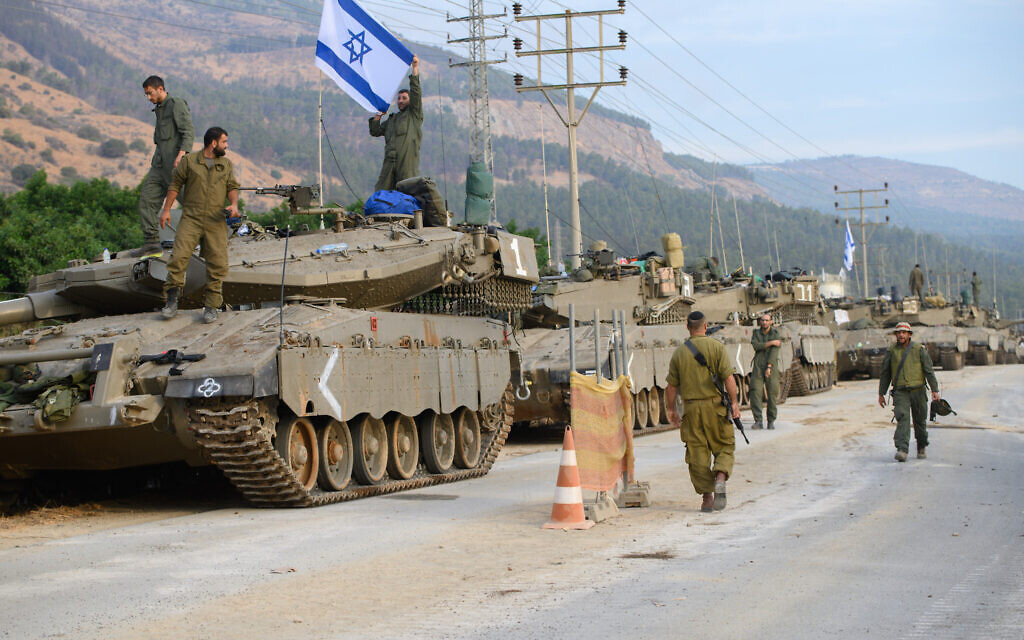
IDF Armored forces at a staging area in Upper Galilee, near the northern Israeli border with Lebanon, October 11, 2023. (Ayal Margolin/Flash90)
Hamas launched a massive assault on southern Israel on Saturday morning, murdering over 1,000 men, women and children and kidnapping an estimated 130 hostages. Thousands of people were injured in the well-planned and highly organised sneak attack which took place on Shabbat, while many Israelis were journeying to synagogues to celebrate the festival of Shemini Atzeret.
What happened
- The terrorist attack represented the bloodiest day in Jewish history since the Holocaust – proportionately, the loss of life on Saturday was greater than on 9/11.
- Reports have implicated Iran in the atrocities committed by its proxy army.
- The unprecedented invasion from Gaza – which penetrated 15 miles into Israel, reached the city of Sderot and was accompanied by a barrage of more than 2,000 rockets – took place a day after Israel marked the 50th anniversary of the start of the Yom Kippur War. The Israeli intelligence and security forces appear to have been taken completely by surprise, just as they were in 1973.
- Israel has formally declared a state of war, called up 300,000 reservists and launched “Operation Iron Swords”.
- On Tuesday morning, 72 hours after the assault began, the IDF was finally able to say the Gaza border had been sealed, although central and southern Israel, including Tel Aviv, Jerusalem and Ashkelon, continues to come under intermittent rocket fire and fears remain that Hamas terrorists who infiltrated Israel may still be at large. Overall, there have now been over 4,500 rockets directed at Israel.
- The Israeli military says the bodies of 1,500 terrorists have been located around southern Israel. Last night, two more terrorists were killed near Kibbutz Mefalsim.
- The Lebanese terror group Hezbollah – another Iranian proxy group committed to Israel’s destruction – began firing rockets and mortars into northern Israel on Sunday “in solidarity” with the continuing Hamas attack. The attacks continued on Tuesday. Monday also saw minor clashes between Palestinian Islamic Jihad terrorists and the IDF on the Lebanese border, killing two soldiers.
- The Palestinian president, Mahmoud Abbas, refused to condemn the Hamas attack, characterising it as “the right of the Palestinian people to defend themselves” and agreeing to travel to Moscow to meet Vladimir Putin. The Russian president said the attacks were “a clear example of the failure of US policy in the Middle East”. There were street celebrations in a number of West Bank cities.
- President Biden joined Britain, France, Germany and Italy in issuing a joint statement on Monday which expressed “our steadfast and united support to the State of Israel, and our unequivocal condemnation of Hamas and its appalling acts of terrorism”. The leaders pledged: “Our countries will support Israel in its efforts to defend itself and its people against such atrocities.”
- Forty-eight hours after the assault, the Palestinian Solidarity Campaign organised a demonstration outside the Israeli embassy in London at which not a single speaker reportedly condemned Hamas’ terror attack. Jeremy Corbyn also refused to condemn Hamas, saying only: “all attacks are wrong”.
How did it happen?
Even as Israel goes to war, big questions are being asked about the political, intelligence and military failures which allowed Saturday’s catastrophe to occur. These will likely be the focus of a post-war commission of inquiry, but already there are theories surrounding an alleged “groupthink” which led to a belief that Hamas was deterred; indications that the terror group deliberately fooled Israel into thinking it was interested in getting economic incentives, such as cash from Qatar and increased work permits from Israel, while it trained terrorists and conducted simulations; and suggestions that the government had moved troops from the Gaza border to the West Bank. The military also sounded warnings months ago that the government’s contentious judicial reforms were weakening Israel’s strategic position.
The grim toll
Latest figures suggest that over 1,000 Israelis have been killed, with over 3,400 injured. More than 500 people remain in hospital, many with life-threatening injuries. 156 of the Israeli dead were soldiers, although that number is expected to rise.
- Having paraded its injured and bloodied hostages through the streets of Gaza, Hamas on Monday threatened to begin murdering its prisoners – and posting the footage online – if the Israeli air force didn’t cease its operations. Entire families, children and the elderly – reportedly including a Holocaust survivor and a peace activist who volunteered to help Palestinian residents of Gaza needing medical treatment in Israel – were kidnapped by Hamas gunmen from their homes. The Red Cross said its attempts to gain access to the hostages had so far not succeeded.
- One of the worst atrocities took place near Kibbutz Re’im, where some 3,000 mainly young people were enjoying the Nova outdoor music festival. On Sunday, Israeli rescuers said they had recovered the bodies of 260 victims of the Hamas massacre. One eyewitness account described the rape of young women beside their dead friends.
- More than 10 Britons are feared dead or missing. Two of the victims have been named as 20-year-old Nathanel Young and Bernard Cowan. The death toll also includes Americans, Argentines, Thais and Nepalese.
- Visiting K’far Aza – a village close to the Gaza border held for 48 hours by Hamas terrorist, ITV reporter John Ray tweeted on Tuesday: “We are seeing scenes of unimaginable horror”. An Israeli officer at the scene told him: “It reminds me of the pogroms and of the Nazis.” Another said men, women and children were slaughtered in their beds on Saturday morning. “It was not a battlefield here. It was a massacre. They were defenceless.” According to international media reports, at least 40 babies were massacred at the kibbutz by Hamas terrorists.
The Iranian connection
Tehran warmly welcomed the attacks by its proxy army, with the supreme leader, Ayatollah Khamenei, hailing an “epic” victory. “We do kiss the foreheads and the arms of the smart masterminds and the Palestinian youths,” he told military cadets. The foreign ministry lauded “a bright spot in the history of the Palestinian people’s struggle against the Zionists”.
But despite Khamenei’s denials, evidence directly linking the Iranian regime – which funds and arms Hamas, Hezbollah and PIJ – with the attacks is beginning to mount. The Wall Street Journal reported on Monday that Iran’s involvement in preparations for the attack began in August, with final sign-off coming from the Islamic Revolutionary Guard Corps officials at a meeting in Beirut a week ago.
How the assault unfolded
Saturday’s assault began with Hamas using drones to attack Israeli observation towers and weapons systems on the border, terrorists then deployed paragliders to cross the border with a massive bombardment of rockets into southern and central Israel providing a diversion. Finally, holes were blown in the fence, allowing the further infiltration of Hamas terrorists. Once inside Israel, the terrorists sped towards kibbutzim, villages and towns in a convoy of pickup trucks and and motorbikes. They systemically searched house-to-house, heading straight to public and private bomb shelters. Homes were set alight to smoke residents out of safe rooms and bomb shelters. Motorists were shot on sight in their cars, and people waiting at bus stops murdered.
Israel responds
- Israel has vowed to destroy the threat Hamas poses to Israel. Avi Dichter, the minister for agriculture and rural development and a former director of Shin Bet, said it aimed to strip Hamas of its capabilities, “denying or destroying the military terrorist infrastructure used by Hamas and Islamic Jihad and damaging Hamas’s governance in Gaza”.
- By the fourth day of its operation, Israel had struck 1,707 Hamas targets in the Gaza Strip, including 475 rocket systems, 73 command centres, 23 strategic infrastructure sites, and 22 underground targets. A ground incursion into Gaza appears imminent.
- In an operation targeting a “nest of terror” in Gaza City on Monday evening, Israel killed two senior Hamas leaders. The IDF said Jawad Abu Shamala managed the terror group’s funds, “and earmarked funds for financing and directing terror in and outside the Gaza Strip” while Zakariya Abu Moammar was the head of the terror group’s internal relations. “He was a senior Hamas decision-maker and coordinator between terror groups in the Gaza Strip,” the IDF said.
- Defence minister Yoav Gallant ordered a tightening of the restrictions imposed by Israel and Egypt on Gaza after Hamas’ 2007 seizure of power.
- The Hamas-run health ministry claims over 800 Gazans have been killed – 400 of whom were terrorist fighters, according to the IDF – with some 3,890 injured.
- Israel has urged civilians to leave Gaza during its operations using the border crossing into Egypt. Around 137,000 Gazans have now reportedly left their homes.
A new government?
After months of bitter argument over the Netanyahu government’s planned judicial reforms, opposition leaders called for a united front to take on Hamas. A joint statement by Yesh Atid head Yair Lapid, National Unity head Benny Gantz, Yisrael Beitenu head Avigdor Lieberman and Labor party head Merav Michaeli said: “In days like these there is no opposition and no coalition in Israel.” We “are united in the face of terrorism” and the need to strike with “a strong and determined fist”. In preparation for the expected establishment of an “emergency national government” to prosecute the war, the governing coalition agreed to an expansion of the administration to include opposition politicians. While Lapid has ruled out joining if the far-right Religious Zionism and Otzma Yehudit parties remain in the coalition, Gantz is believed to be close to striking a deal with the prime minister. Gantz has indicated he wants a small “war cabinet” which would exclude ministers without “relevant” military experience, effectively excluding many of the far-right and ultra-Orthodox ministers.


